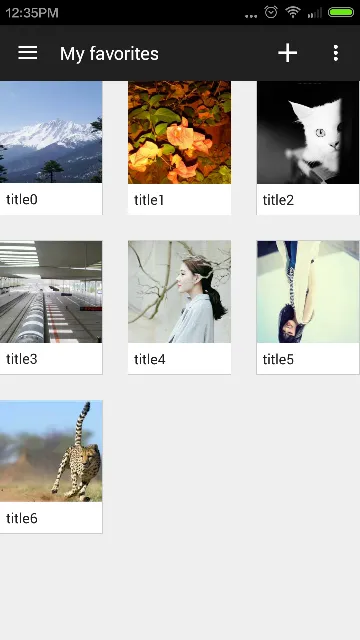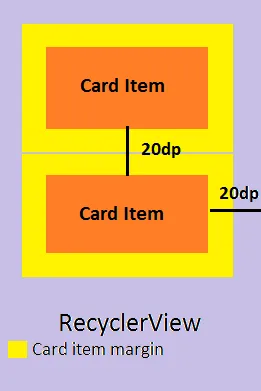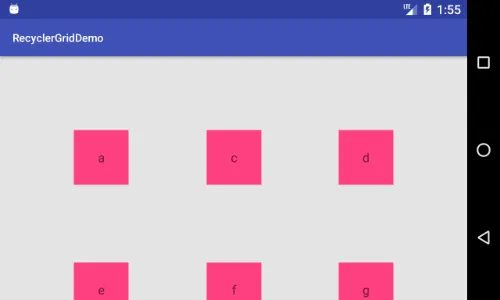如何使用GridLayoutManager设置RecyclerView的列间距?在布局内设置margin/padding没有效果。
安卓Recyclerview的GridLayoutManager列间距问题
4
以下代码能够良好运行,每列宽度相同:
public class GridSpacingItemDecoration extends RecyclerView.ItemDecoration {
private int spanCount;
private int spacing;
private boolean includeEdge;
public GridSpacingItemDecoration(int spanCount, int spacing, boolean includeEdge) {
this.spanCount = spanCount;
this.spacing = spacing;
this.includeEdge = includeEdge;
}
@Override
public void getItemOffsets(Rect outRect, View view, RecyclerView parent, RecyclerView.State state) {
int position = parent.getChildAdapterPosition(view); // item position
int column = position % spanCount; // item column
if (includeEdge) {
outRect.left = spacing - column * spacing / spanCount; // spacing - column * ((1f / spanCount) * spacing)
outRect.right = (column + 1) * spacing / spanCount; // (column + 1) * ((1f / spanCount) * spacing)
if (position < spanCount) { // top edge
outRect.top = spacing;
}
outRect.bottom = spacing; // item bottom
} else {
outRect.left = column * spacing / spanCount; // column * ((1f / spanCount) * spacing)
outRect.right = spacing - (column + 1) * spacing / spanCount; // spacing - (column + 1) * ((1f / spanCount) * spacing)
if (position >= spanCount) {
outRect.top = spacing; // item top
}
}
}
}
使用方法
1. 无边缘

int spanCount = 3; // 3 columns
int spacing = 50; // 50px
boolean includeEdge = false;
recyclerView.addItemDecoration(new GridSpacingItemDecoration(spanCount, spacing, includeEdge));
2. 使用edge浏览器

int spanCount = 3; // 3 columns
int spacing = 50; // 50px
boolean includeEdge = true;
recyclerView.addItemDecoration(new GridSpacingItemDecoration(spanCount, spacing, includeEdge));
19
RecyclerView支持ItemDecoration的概念:在每个元素周围进行特殊的偏移和绘制。正如这个答案所示,您可以使用
public class SpacesItemDecoration extends RecyclerView.ItemDecoration {
private int space;
public SpacesItemDecoration(int space) {
this.space = space;
}
@Override
public void getItemOffsets(Rect outRect, View view,
RecyclerView parent, RecyclerView.State state) {
outRect.left = space;
outRect.right = space;
outRect.bottom = space;
// Add top margin only for the first item to avoid double space between items
if (parent.getChildLayoutPosition(view) == 0) {
outRect.top = space;
} else {
outRect.top = 0;
}
}
}
然后通过添加它
mRecyclerView = (RecyclerView) rootView.findViewById(R.id.my_recycler_view);
int spacingInPixels = getResources().getDimensionPixelSize(R.dimen.spacing);
mRecyclerView.addItemDecoration(new SpacesItemDecoration(spacingInPixels));
14
如果你想要实现每个项目周围的等距和等大小,以下是逐步简单的解决方案。
ItemOffsetDecoration
public class ItemOffsetDecoration extends RecyclerView.ItemDecoration {
private int mItemOffset;
public ItemOffsetDecoration(int itemOffset) {
mItemOffset = itemOffset;
}
public ItemOffsetDecoration(@NonNull Context context, @DimenRes int itemOffsetId) {
this(context.getResources().getDimensionPixelSize(itemOffsetId));
}
@Override
public void getItemOffsets(Rect outRect, View view, RecyclerView parent,
RecyclerView.State state) {
super.getItemOffsets(outRect, view, parent, state);
outRect.set(mItemOffset, mItemOffset, mItemOffset, mItemOffset);
}
}
实现
在你的源代码中,将ItemOffsetDecoration添加到你的RecyclerView中。
物品偏移值应该是你想要添加的项之间空格实际值的一半大小。
mRecyclerView.setLayoutManager(new GridLayoutManager(context, NUM_COLUMNS);
ItemOffsetDecoration itemDecoration = new ItemOffsetDecoration(context, R.dimen.item_offset);
mRecyclerView.addItemDecoration(itemDecoration);
同时,将项目偏移值设置为其RecyclerView的填充,并指定android:clipToPadding=false。
<android.support.v7.widget.RecyclerView
android:id="@+id/recyclerview_grid"
android:layout_width="match_parent"
android:layout_height="match_parent"
android:clipToPadding="false"
android:padding="@dimen/item_offset"/>
1
试试这个。它会处理好所有的等距间距,适用于列表、网格和交错网格。
编辑
更新的代码应该能够处理大多数带有跨度、方向等特殊情况的情形。 请注意,如果在GridLayoutManager中使用setSpanSizeLookup(),为了提高性能,建议设置setSpanIndexCacheEnabled()。
需要注意的是,在使用StaggeredGrid时,似乎存在一个错误,导致子项的索引变得混乱且难以追踪,因此下面的代码可能无法很好地与StaggeredGridLayoutManager配合使用。
public class ListSpacingDecoration extends RecyclerView.ItemDecoration {
private static final int VERTICAL = OrientationHelper.VERTICAL;
private int orientation = -1;
private int spanCount = -1;
private int spacing;
private int halfSpacing;
public ListSpacingDecoration(Context context, @DimenRes int spacingDimen) {
spacing = context.getResources().getDimensionPixelSize(spacingDimen);
halfSpacing = spacing / 2;
}
public ListSpacingDecoration(int spacingPx) {
spacing = spacingPx;
halfSpacing = spacing / 2;
}
@Override
public void getItemOffsets(Rect outRect, View view, RecyclerView parent, RecyclerView.State state) {
super.getItemOffsets(outRect, view, parent, state);
if (orientation == -1) {
orientation = getOrientation(parent);
}
if (spanCount == -1) {
spanCount = getTotalSpan(parent);
}
int childCount = parent.getLayoutManager().getItemCount();
int childIndex = parent.getChildAdapterPosition(view);
int itemSpanSize = getItemSpanSize(parent, childIndex);
int spanIndex = getItemSpanIndex(parent, childIndex);
/* INVALID SPAN */
if (spanCount < 1) return;
setSpacings(outRect, parent, childCount, childIndex, itemSpanSize, spanIndex);
}
protected void setSpacings(Rect outRect, RecyclerView parent, int childCount, int childIndex, int itemSpanSize, int spanIndex) {
outRect.top = halfSpacing;
outRect.bottom = halfSpacing;
outRect.left = halfSpacing;
outRect.right = halfSpacing;
if (isTopEdge(parent, childCount, childIndex, itemSpanSize, spanIndex)) {
outRect.top = spacing;
}
if (isLeftEdge(parent, childCount, childIndex, itemSpanSize, spanIndex)) {
outRect.left = spacing;
}
if (isRightEdge(parent, childCount, childIndex, itemSpanSize, spanIndex)) {
outRect.right = spacing;
}
if (isBottomEdge(parent, childCount, childIndex, itemSpanSize, spanIndex)) {
outRect.bottom = spacing;
}
}
@SuppressWarnings("all")
protected int getTotalSpan(RecyclerView parent) {
RecyclerView.LayoutManager mgr = parent.getLayoutManager();
if (mgr instanceof GridLayoutManager) {
return ((GridLayoutManager) mgr).getSpanCount();
} else if (mgr instanceof StaggeredGridLayoutManager) {
return ((StaggeredGridLayoutManager) mgr).getSpanCount();
} else if (mgr instanceof LinearLayoutManager) {
return 1;
}
return -1;
}
@SuppressWarnings("all")
protected int getItemSpanSize(RecyclerView parent, int childIndex) {
RecyclerView.LayoutManager mgr = parent.getLayoutManager();
if (mgr instanceof GridLayoutManager) {
return ((GridLayoutManager) mgr).getSpanSizeLookup().getSpanSize(childIndex);
} else if (mgr instanceof StaggeredGridLayoutManager) {
return 1;
} else if (mgr instanceof LinearLayoutManager) {
return 1;
}
return -1;
}
@SuppressWarnings("all")
protected int getItemSpanIndex(RecyclerView parent, int childIndex) {
RecyclerView.LayoutManager mgr = parent.getLayoutManager();
if (mgr instanceof GridLayoutManager) {
return ((GridLayoutManager) mgr).getSpanSizeLookup().getSpanIndex(childIndex, spanCount);
} else if (mgr instanceof StaggeredGridLayoutManager) {
return childIndex % spanCount;
} else if (mgr instanceof LinearLayoutManager) {
return 0;
}
return -1;
}
@SuppressWarnings("all")
protected int getOrientation(RecyclerView parent) {
RecyclerView.LayoutManager mgr = parent.getLayoutManager();
if (mgr instanceof LinearLayoutManager) {
return ((LinearLayoutManager) mgr).getOrientation();
} else if (mgr instanceof GridLayoutManager) {
return ((GridLayoutManager) mgr).getOrientation();
} else if (mgr instanceof StaggeredGridLayoutManager) {
return ((StaggeredGridLayoutManager) mgr).getOrientation();
}
return VERTICAL;
}
protected boolean isLeftEdge(RecyclerView parent, int childCount, int childIndex, int itemSpanSize, int spanIndex) {
if (orientation == VERTICAL) {
return spanIndex == 0;
} else {
return (childIndex == 0) || isFirstItemEdgeValid((childIndex < spanCount), parent, childIndex);
}
}
protected boolean isRightEdge(RecyclerView parent, int childCount, int childIndex, int itemSpanSize, int spanIndex) {
if (orientation == VERTICAL) {
return (spanIndex + itemSpanSize) == spanCount;
} else {
return isLastItemEdgeValid((childIndex >= childCount - spanCount), parent, childCount, childIndex, spanIndex);
}
}
protected boolean isTopEdge(RecyclerView parent, int childCount, int childIndex, int itemSpanSize, int spanIndex) {
if (orientation == VERTICAL) {
return (childIndex == 0) || isFirstItemEdgeValid((childIndex < spanCount), parent, childIndex);
} else {
return spanIndex == 0;
}
}
protected boolean isBottomEdge(RecyclerView parent, int childCount, int childIndex, int itemSpanSize, int spanIndex) {
if (orientation == VERTICAL) {
return isLastItemEdgeValid((childIndex >= childCount - spanCount), parent, childCount, childIndex, spanIndex);
} else {
return (spanIndex + itemSpanSize) == spanCount;
}
}
protected boolean isFirstItemEdgeValid(boolean isOneOfFirstItems, RecyclerView parent, int childIndex) {
int totalSpanArea = 0;
if (isOneOfFirstItems) {
for (int i = childIndex; i >= 0; i--) {
totalSpanArea = totalSpanArea + getItemSpanSize(parent, i);
}
}
return isOneOfFirstItems && totalSpanArea <= spanCount;
}
protected boolean isLastItemEdgeValid(boolean isOneOfLastItems, RecyclerView parent, int childCount, int childIndex, int spanIndex) {
int totalSpanRemaining = 0;
if (isOneOfLastItems) {
for (int i = childIndex; i < childCount; i++) {
totalSpanRemaining = totalSpanRemaining + getItemSpanSize(parent, i);
}
}
return isOneOfLastItems && (totalSpanRemaining <= spanCount - spanIndex);
}
}
希望这有所帮助。
7
只有一个简单的解决方案,您可以在需要的任何地方记住并实施。没有错误,没有疯狂的计算。将边距放在卡片/项目布局中,并将相同大小的填充放在RecyclerView中:
item_layout.xml
<CardView
android:layout_width="match_parent"
android:layout_height="wrap_content"
android:margin="10dp">
activity_layout.xml
<RecyclerView
android:layout_width="match_parent"
android:layout_height="wrap_content"
android:padding="10dp"/>
7
public class SpacesItemDecoration extends RecyclerView.ItemDecoration {
private int halfSpace;
public SpacesItemDecoration(int space) {
this.halfSpace = space / 2;
}
@Override
public void getItemOffsets(Rect outRect, View view, RecyclerView parent, RecyclerView.State state) {
if (parent.getPaddingLeft() != halfSpace) {
parent.setPadding(halfSpace, halfSpace, halfSpace, halfSpace);
parent.setClipToPadding(false);
}
outRect.top = halfSpace;
outRect.bottom = halfSpace;
outRect.left = halfSpace;
outRect.right = halfSpace;
}
}
然后使用它
mRecyclerView.addItemDecoration(new SpacesItemDecoration(mMargin));
7
SpaceItemDecoration 实际上是将填充添加到父级(即回收视图)中。 - Mark HetheringtonhalfSpace填充出现(在右侧)。 - Samir(请注意,这仅适用于GridLayoutManager。)
public class GridSpacesItemDecoration extends RecyclerView.ItemDecoration {
private final boolean includeEdge;
private int spacing;
public GridSpacesItemDecoration(int spacing, boolean includeEdge) {
this.spacing = spacing;
this.includeEdge = includeEdge;
}
@Override
public void getItemOffsets(Rect outRect, View view, RecyclerView parent, RecyclerView.State state) {
if (parent.getLayoutManager() instanceof GridLayoutManager) {
GridLayoutManager layoutManager = (GridLayoutManager)parent.getLayoutManager();
int spanCount = layoutManager.getSpanCount();
int position = parent.getChildAdapterPosition(view); // item position
int column = position % spanCount; // item column
if (includeEdge) {
outRect.left = spacing - column * spacing / spanCount; // spacing - column * ((1f / spanCount) * spacing)
outRect.right = (column + 1) * spacing / spanCount; // (column + 1) * ((1f / spanCount) * spacing)
if (position < spanCount) { // top edge
outRect.top = spacing;
}
outRect.bottom = spacing; // item bottom
} else {
outRect.left = column * spacing / spanCount; // column * ((1f / spanCount) * spacing)
outRect.right = spacing - (column + 1) * spacing / spanCount; // spacing - (column + 1) * ((1f / spanCount) * spacing)
if (position >= spanCount) {
outRect.top = spacing; // item top
}
}
}
}
}
如果有人感兴趣,这里是 GridAutofitLayoutManager:
public class GridAutofitLayoutManager extends GridLayoutManager {
private int mColumnWidth;
private boolean mColumnWidthChanged = true;
public GridAutofitLayoutManager(Context context, int columnWidth)
{
/* Initially set spanCount to 1, will be changed automatically later. */
super(context, 1);
setColumnWidth(checkedColumnWidth(context, columnWidth));
}
public GridAutofitLayoutManager(Context context,int unit, int columnWidth)
{
/* Initially set spanCount to 1, will be changed automatically later. */
super(context, 1);
int pixColumnWidth = (int) TypedValue.applyDimension(unit, columnWidth, context.getResources().getDisplayMetrics());
setColumnWidth(checkedColumnWidth(context, pixColumnWidth));
}
public GridAutofitLayoutManager(Context context, int columnWidth, int orientation, boolean reverseLayout)
{
/* Initially set spanCount to 1, will be changed automatically later. */
super(context, 1, orientation, reverseLayout);
setColumnWidth(checkedColumnWidth(context, columnWidth));
}
private int checkedColumnWidth(Context context, int columnWidth)
{
if (columnWidth <= 0)
{
/* Set default columnWidth value (48dp here). It is better to move this constant
to static constant on top, but we need context to convert it to dp, so can't really
do so. */
columnWidth = (int) TypedValue.applyDimension(TypedValue.COMPLEX_UNIT_DIP, 48,
context.getResources().getDisplayMetrics());
}
return columnWidth;
}
public void setColumnWidth(int newColumnWidth)
{
if (newColumnWidth > 0 && newColumnWidth != mColumnWidth)
{
mColumnWidth = newColumnWidth;
mColumnWidthChanged = true;
}
}
@Override
public void onLayoutChildren(RecyclerView.Recycler recycler, RecyclerView.State state)
{
int width = getWidth();
int height = getHeight();
if (mColumnWidthChanged && mColumnWidth > 0 && width > 0 && height > 0)
{
int totalSpace;
if (getOrientation() == VERTICAL)
{
totalSpace = width - getPaddingRight() - getPaddingLeft();
}
else
{
totalSpace = height - getPaddingTop() - getPaddingBottom();
}
int spanCount = Math.max(1, totalSpace / mColumnWidth);
setSpanCount(spanCount);
mColumnWidthChanged = false;
}
super.onLayoutChildren(recycler, state);
}
}
最后:
mDevicePhotosView.setLayoutManager(new GridAutofitLayoutManager(getContext(), getResources().getDimensionPixelSize(R.dimen.item_size)));
mDevicePhotosView.addItemDecoration(new GridSpacesItemDecoration(Util.dpToPx(getContext(), 2),true));
2
layoutManager.getPosition(view),然后检查该位置是否为零,这将是您的标题。此外,这种方法可以让您在任何位置添加另一个标题 :) - Mina Samir如果你想在所有设备上固定你的RecyclerView项的大小,你可以这样做:
public class GridSpacingItemDecoration extends RecyclerView.ItemDecoration {
private int mSpanCount;
private float mItemSize;
public GridSpacingItemDecoration(int spanCount, int itemSize) {
this.mSpanCount = spanCount;
mItemSize = itemSize;
}
@Override
public void getItemOffsets(final Rect outRect, final View view, RecyclerView parent,
RecyclerView.State state) {
final int position = parent.getChildLayoutPosition(view);
final int column = position % mSpanCount;
final int parentWidth = parent.getWidth();
int spacing = (int) (parentWidth - (mItemSize * mSpanCount)) / (mSpanCount + 1);
outRect.left = spacing - column * spacing / mSpanCount;
outRect.right = (column + 1) * spacing / mSpanCount;
if (position < mSpanCount) {
outRect.top = spacing;
}
outRect.bottom = spacing;
}
}
recyclerview_item.xml
<LinearLayout
xmlns:android="http://schemas.android.com/apk/res/android"
android:layout_width="@dimen/recycler_view_item_width"
...
>
...
</LinearLayout>
dimens.xml
<dimen name="recycler_view_item_width">60dp</dimen>
活动
int numberOfColumns = 3;
mRecyclerView.setLayoutManager(new GridLayoutManager(this, numberOfColumns));
mRecyclerView.setAdapter(...);
mRecyclerView.addItemDecoration(new GridSpacingItemDecoration(3,
getResources().getDimensionPixelSize(R.dimen.recycler_view_item_width)));
3
所选答案几乎完美,但根据空间的不同,项目宽度可能不相等。(在我的情况下,这很关键)。因此,我最终采用了以下代码,稍微增加了一些空间,使得所有项目宽度都相同。
class GridSpacingItemDecoration(private val columnCount: Int, @Px preferredSpace: Int, private val includeEdge: Boolean): RecyclerView.ItemDecoration() {
/**
* In this algorithm space should divide by 3 without remnant or width of items can have a difference
* and we want them to be exactly the same
*/
private val space = if (preferredSpace % 3 == 0) preferredSpace else (preferredSpace + (3 - preferredSpace % 3))
override fun getItemOffsets(outRect: Rect, view: View, parent: RecyclerView, state: RecyclerView.State?) {
val position = parent.getChildAdapterPosition(view)
if (includeEdge) {
when {
position % columnCount == 0 -> {
outRect.left = space
outRect.right = space / 3
}
position % columnCount == columnCount - 1 -> {
outRect.right = space
outRect.left = space / 3
}
else -> {
outRect.left = space * 2 / 3
outRect.right = space * 2 / 3
}
}
if (position < columnCount) {
outRect.top = space
}
outRect.bottom = space
} else {
when {
position % columnCount == 0 -> outRect.right = space * 2 / 3
position % columnCount == columnCount - 1 -> outRect.left = space * 2 / 3
else -> {
outRect.left = space / 3
outRect.right = space / 3
}
}
if (position >= columnCount) {
outRect.top = space
}
}
}
}
1
columnCount == 1 -> {
outRect.left = space
outRect.right = space
} - massivemadness当使用CardView时,子项之间的空格问题可以通过将app:cardUseCompatPadding设置为true来解决。
对于更大的边距,请增加项目高程。 CardElevation是可选的(使用默认值)。
<androidx.cardview.widget.CardView
xmlns:app="http://schemas.android.com/apk/res-auto"
app:cardUseCompatPadding="true"
app:cardElevation="2dp">
原文链接
- 相关问题
- 70 使用GridLayoutManager和RecyclerView更改列数
- 24 使用RecyclerView GridLayoutManager和ItemDecoration实现列间距时,项目的宽度不相同。
- 5 如何使用GridLayoutManager在RecyclerView中移除行之间的间距
- 5 使用GridLayoutManager的RecyclerView
- 3 安卓RecyclerView分页问题
- 3 安卓:RecyclerView项上下文菜单问题
- 3 如何在安卓中的Recycler View(GridLayoutManager)中减少列之间的间距
- 9 安卓RecyclerView绘制问题(闪烁)
- 5 安卓RelativeLayout间距
- 9 RecyclerView使用GridLayoutManager尝试解决wrap_content问题



GridLayoutManager并重写generateDefaultLayoutParams()及其相关方法吗? - CommonsWare